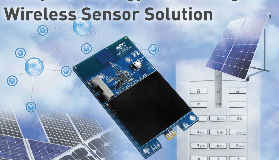SiLabs rocks: $45 energy harvesting reference design
on

Silicon Laboratories Inc. recently introduced the industry's most energy-efficient wireless sensor node solution powered by a solar energy harvesting source. The new turnkey energy harvesting reference design enables developers to implement self-sustaining, ultra-low-power wireless sensor networks for home and building automation, security systems, industrial control applications, medical monitoring devices, asset tracking systems and infrastructure and agricultural monitoring systems.
Silicon Labs new single-chip MCU and wireless transceiver solution, the Si10xx can perform control and wireless interface functions at ultra-low power levels. In addition to being environmentally friendly and virtually inexhaustible, harvested energy provides a cost-effective, convenient alternative to batteries in many applications such as wireless networking systems. Batteries can be costly and inconvenient to replace, especially in large-scale wireless sensor node applications, and they are unreliable in extreme temperature conditions. Wireless sensor nodes often use batteries because they are placed in locations where it is not possible or convenient to run mains power. Energy harvesting simplifies these applications by eliminating the inconvenience of replacing batteries in inaccessible locations, while also reducing the quantity of depleted batteries for recycling or dumped in landfills.
Silicon Labs' comprehensive energy harvesting reference design includes wireless network and USB software and a complete circuit design with RF layout, bill of materials (BOM), schematics and Gerber files. The design consists of three components:
a solar-powered wireless sensor node that measures temperature, light level and charge level, using an Si10xx wireless MCU to control the sensor system and transmit data wirelessly and a thin-film battery to store harvested energy.
a wireless USB adapter that connects the wireless sensor node to a PC for displaying sensor data; the adapter features Silicon Labs' Si4431 EZRadioPRO® transceiver with an MCU running USB-HID class software and EZMac® wireless software stack.
A wireless sensor network GUI that displays data from up to four sensor nodes.
The thin film battery used in the energy harvesting reference design has a capacity of 0.7 mAh. In direct sunlight, the battery can be recharged fully in only two hours. While in sleep mode, the wireless sensor node will retain a charge for 7,000 hours. If the wireless system is transmitting continuously, it will operate non-stop for about three hours, although it is designed to constantly recharge itself at an appropriate level to keep the thin-film battery from completely discharging.
The new reference design accommodates a wide range of harvested energy sources. An on-board bypass connector gives developers the flexibility to bypass the solar cell and tap other energy harvesting sources such as vibration (piezoelectric), thermal and RF.
Silicon Labs’ energy harvesting reference design is available now and priced at $45 (USD).


Discussion (0 comments)